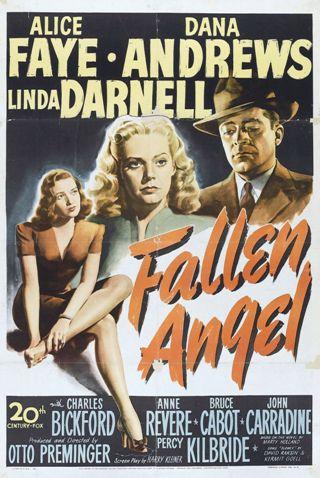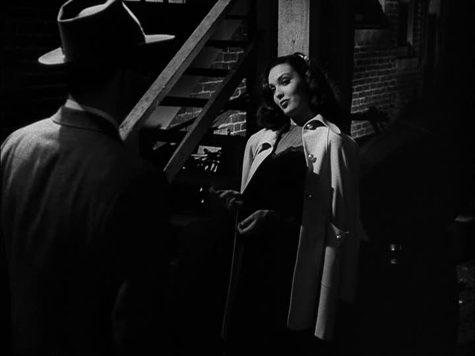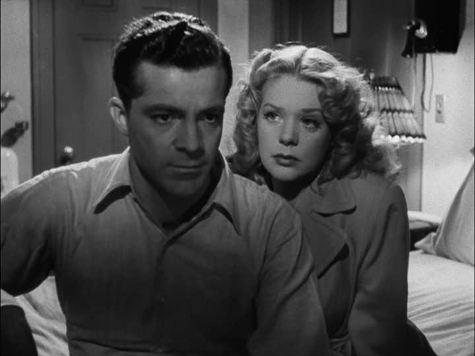
We were born to tread the earth as angels, to seek out Heaven this side of the sky. But they who race above shall stumble in the dark and fall from grace. Then love alone can make the fallen angel rise. For only two together can enter Paradise.
Film noir is primarily an urban-based style of filmmaking, and derives many of its motifs from the faceless anonymity and frequently hostile isolation that characterize big city life. However, it would be a mistake to think that noir cannot exist outside of this particular environment. There are plenty of examples of the form to be found in a variety of settings – it’s this flexibility that is one of its strengths. While the metropolitan sprawl may well offer enhanced opportunities for portraying bleak, fatalistic tales, the small town, with all its attendant possibilities, represents another fertile setting. The more limited environment may not suggest the kind of impersonal alienation of larger urban surroundings, but the sense of community that exists (regardless of whether it’s shown in a positive or negative light) has its own claustrophobic atmosphere. Otto Preminger’s Fallen Angel (1945) occupies a kind of middle ground, with the majority of the action taking place in a small tightly knit settlement but also featuring short interludes in San Francisco.
The film actually opens at a sort of geographical mid-point, one could almost say the middle of nowhere. After the credits, inventively flashed up on screen as a series of road signs seen through the windshield of a bus speeding through the night, we’re introduced to Eric Stanton (Dana Andrews), and it’s immediately obvious that this is a down on his luck chancer. Not having enough money to ride the bus any further, Stanton finds himself tossed onto the road. With just a dollar in his pocket, he’s stranded in a small town, halfway between Los Angeles and San Francisco. It’s one of those sleepy little places where everybody knows each other and there’s not much to do. Stanton wanders into the local diner, right in the middle of what appears to be some kind of investigation. The owner, Pop (Percy Kilbride), is an anxious man – his waitress has apparently gone missing and he’s clearly distressed. A local cop and a former New York lawman, Judd (Charles Bickford), listen sympathetically and offers reassurance. As Stanton orders some food, the door of the diner opens and a weary but flashily dressed young woman strolls in. This is Stella (Linda Darnell), the source of all the panic a moment earlier. What’s immediately apparent is that Stella is arguably the hottest property in town; Pop is fawning and all puppy-dog eyes, Judd looks on with something approaching warmth, and Stanton too is unmistakably drawn to her. Stanton may be down to his last buck but he’s also the consummate opportunist. Spotting an advertisement for a visiting spiritualist, Stanton talks his way into acting as the promoter for the upcoming spook show. While Stanton might seem like the cat that always lands on its feet, this latest piece of maneuvering will actually drop him right into the center of a maelstrom of passion lurking beneath the deceptively calm surface of the little coastal town. In falling for the insolent and sensual charms of Stella, he hits upon what he thinks is the perfect plan to win her over; Stella is no fool and wants a man who is willing and able to marry her and take her out of the dead-end job in this backwater. To this end, Stanton hatches a scheme to court and marry a rich heiress, June Mills (Alice Faye), divorce her and run off with Stella. However, it won’t be that easy. Too many men want Stella for themselves, June really falls for Stanton, and a murder will take place. I’m not going to reveal who dies or who did the deed, I’ll say only that Stanton becomes the prime suspect and he will have to unravel the tangled web of deceit and thwarted desire if he’s to have any chance of clearing his name.

Otto Preminger had made his mark with the highly successful Laura, and Fallen Angel can be seen as an effort to build on that, reuniting the director with Dana Andrews along with cameraman Joseph LaShelle and composer David Raksin. There are those who argue that Laura isn’t full-blown noir; while I wouldn’t necessarily go along with that assessment I can see where it’s coming from. With Fallen Angel, however, there can be no doubt about its categorization. The plot, themes, milieu and cinematography are all characteristically noir. In visual terms, this style of cinema is all about light and shadow – thematically, faith and despair are the key. Fallen Angel checks all the boxes on this score. Film noir concerns itself with dissatisfaction and the desire of individuals to escape their circumstances more than anything else. Escape is certainly the prime motivation of all the characters in this movie: we’re taken on a tour of a world populated by people desperate to break free of social constraints, unfulfilling relationships, financial difficulties, and just plain old bad luck. If you watch enough of these kinds of films then, time and again, you run across characters in the concrete jungles champing at the bit to return to the land or to emigrate, while those in the country yearn for the perceived glamor and excitement of brightly lit cities. This is very much the case with Fallen Angel – everybody in the picture has dreams and aspirations, and all of these inevitably descend into nightmare.
Preminger and LaShelle created some wonderful images on the screen, and drew a nice contrast between the small town, where the bulk of the action unfolds, and San Francisco. Contrary to what one might expect, it’s the scenes in the city that have a crisp, clear look whereas the little coastal settlement exists mainly in shadow, reflecting the moral ambiguities hidden passions that lurk there. It’s also worth drawing attention to the skill and ease with which Preminger moves his camera around, at once building tension and drama, revealing secrets and objectifying characters. There’s one particular scene that illustrates what I’m talking about here, taking place on Stanton’s wedding night. Having slipped out of the house to meet with Stella, he quarrels with her and she storms off to keep her date with her current beau. As Stella strides away, Preminger pulls the camera back to show her getting into her lover’s car before tracking forward to focus briefly on Stanton’s scowling features. Instead of allowing the camera to remain there though, the director maintains the forward movement and passes by Stanton to come to rest on the shadowy background, out of which steps the new groom’s disappointed sister-in-law – a masterfully composed shot.

I’ve written at length about Dana Andrews’ abilities before and Fallen Angel proves yet again what a strong screen presence he had. He did some very memorable work throughout the 40s, and Preminger in particular seemed able to get the best out of him. The noir pictures they made together are all quality productions and all of them offered Andrews the opportunity to explore something different. While he had good support in this movie, his was the central role and he remains the main focus. What we have is an essentially insecure individual who cloaks his own recognized inadequacies with smart patter. It’s only relatively late in proceedings, when he’s on the run and panicked, that he reveals his true character. The nonchalant, worldly veneer that he employs to gloss over his fears and paranoia is stripped away and we get a glimpse of the real man, basically a frightened guy who’s been running from danger all his life. In a sense, the beauty of this film stems from the way Andrews’ character develops as a result of his interaction with two very different women. Of the two, Linda Darnell’s Stella is the one that catches the eye; sultry and seductive, Darnell might at first appear to be the fallen angel of the title but that’s not at all the case. Darnell was a genuine beauty and had an earthy charm that is highlighted in this film. All the main characters are stuck on her, but she flits round them all like a firefly, drawing the best and worst out of them. However, it’s Alice Faye’s June that exerts the most powerful influence on Andrews’ drifter. Darnell provokes the conflict among the men but Faye recognizes and draws forth the humanity and half-remembered decency in Andrews. Not being a fan of musicals, I have to admit that I’m not all that familiar with the work of Alice Faye. Nevertheless, I remain highly impressed with her performance in this film. I understand that a good deal of her role ended up on the cutting room floor, prompting her to walk off the Fox lot, but what we’re left with indicates that she had great dramatic potential. I could go on about the depth and talent involved in the supporting cast, but I’ll confine myself to a few words about Charles Bickford. His role here is a pivotal one, maybe as complex as that of the leads and he carries it off very effectively. For a variety of reasons I want to be brief here, so I’ll just say that Bickford does a marvelous job of conveying reassuring menace.
Back when Fox were running their noir line the choices for inclusion sometimes seemed a little arbitrary. Having said that, Fallen Angel is the real deal, a genuine slice of film noir. The R1 DVD is an excellent presentation of the film – it’s sharp, crisp and boasts very strong contrast that really shows off LaShelle’s cinematography. The extra features consist of a commentary track by Eddie Muller and Susan Andrews (the actor’s daughter), a series of galleries and brief liner notes. If one wanted to be critical, then I guess the plot could be viewed as rather contrived. Even so, the whole thing adds up to a highly polished and attractive package. I don’t believe Preminger ever made a poor noir picture, although I’ll have to qualify that by pointing out that I’ve yet to see The 13th Letter, and Fallen Angel must rate among the better ones. As a drama, a thriller, a film noir, or a kind of cock-eyed romance the movie comes highly recommended.
